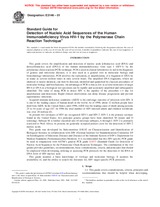We need your consent to use the individual data so that you can see information about your interests, among other things. Click "OK" to give your consent.
ASTM E2146-01
Standard Guide for Detection of Nucleic Acid Sequences of the Human Immunodeficiency Virus HIV-1 by the Polymerase Chain Reaction Technique (Withdrawn 2010)
STANDARD published on 10.5.2001
The information about the standard:
Designation standards: ASTM E2146-01
Note: WITHDRAWN
Publication date standards: 10.5.2001
SKU: NS-44464
The number of pages: 5
Approximate weight : 15 g (0.03 lbs)
Country: American technical standard
Category: Technical standards ASTM
Annotation of standard text ASTM E2146-01 :
Keywords:
AIDS, amplification, DNA primer, DNA probe, HIV, human immunodeficiency virus, PCR, polymerase chain reaction, ICS Number Code 11.100 (Laboratory medicine)
Additional information
| Significance and Use | ||||
|
This guide is intended for use in any laboratory utilizing PCR to amplify DNA sequences or RT-PCR to amplify RNA sequences of HIV from cells, tissues, or body fluids such as whole blood, sera and plasma. The criteria used for the identification and evaluation of the amplification reactions should be administered by an individual trained in the use of molecular biological and microbiological techniques associated with PCR and HIV. |
||||
| 1. Scope | ||||
|
1.1 This guide covers considerations, criteria, principles and recommendations that should be helpful when developing, utilizing, or assessing PCR protocols to amplify and detect DNA (by PCR) or RNA [by reverse transcriptase PCR (RT-PCR)] from HIV. This guide is not a specific protocol for the detection of HIV. It is intended to provide information that will assist the user in obtaining quality and reliable data. The guide is closely related to and should be used concurrently with the general PCR guideline E 1873. 1.2 This guide has been developed for use in any molecular biology or biotechnology laboratory. This includes but is not limited to clinical and diagnostic laboratories involved with HIV detection. 1.3 This guide does not cover details of the various methods such as gel electrophoresis, that can be utilized to identify PCR-amplified HIV nucleic acid sequences, nor does it cover details of instrument (thermocycler) calibration. 1.4 This guide does not cover specific variations of the basic PCR or RT-PCR technology (e.g., quantitative PCR, multiplex PCR and in situ PCR). 1.5 This guide does not address the additional considerations necessary for the performance and validation of a quantitative PCR test for HIV. Note 1—Warning: Laboratory work involving certain clinical specimens and microorganisms can be hazardous to personnel. Note 2—Precaution: Biosafety Level 2 facilities are recommended for potentially hazardous work (2), and many laboratories use Biosafety Level 3 facilities when working with HIV. Safety guidelines should be adhered to according to NCCLS M29-A and other recommendations (2). |
||||
| 2. Referenced Documents | ||||
|
We recommend:
Technical standards updating
Do you want to make sure you use only the valid technical standards?
We can offer you a solution which will provide you a monthly overview concerning the updating of standards which you use.
Would you like to know more? Look at this page.




 Cookies
Cookies
